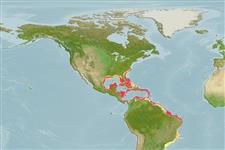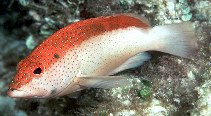Cephalopholis fulva (Linnaeus, 1758)
Coney
Adicionar sua observação em Fish Watcher
| Native range | All suitable habitat | Point map | Year 2050 |

|
| This map was computer-generated and has not yet been reviewed. |
| Cephalopholis fulva AquaMaps Data sources: GBIF OBIS |
Carregue seu(sua) Fotos e vídeos
Pictures | Videos | Sounds | Stamps, coins, misc. | Imagem do GoogleCephalopholis fulva
Picture by Randall, J.E.
Pictures | Videos | Sounds | Stamps, coins, misc. | Imagem do GoogleCephalopholis fulva
Picture by Randall, J.E.
Classificação / Names Nomes comuns | Sinônimos | Catalog of Fishes(Gênero, Espécies) | ITIS | CoL | WoRMS | Cloffa
> Perciformes/Serranoidei (Groupers) > Epinephelidae (Groupers)
Etymology: Cephalopholis: Greek, kephale = head + Greek, pholis = scale (Ref. 45335).
More on author: Linnaeus.
Etymology: Cephalopholis: Greek, kephale = head + Greek, pholis = scale (Ref. 45335).
More on author: Linnaeus.
Environment: milieu / climate zone / depth range / distribution range Ecologia
marinhas associadas(os) a recifes; não migratória; intervalo de profundidade 1 - 150 m (Ref. 26938), usually 1 - 40 m (Ref. 89707). Subtropical; 36°N - 28°S, 98°W - 33°W (Ref. 5222)
Distribuição Países | Áreas da FAO | Ecossistemas | Ocorrências | Point map | Introduções | Faunafri
Western Atlantic: South Carolina, USA and Bermuda to southern Brazil.
Comprimento de primeira maturação / Tamanho / Peso / Idade
Maturity: Lm 14.7 range ? - 24.5 cm
Max length : 44.0 cm TL macho/indeterminado; (Ref. 116036); idade máx. registrada: 11 anos (Ref. 36271)
Max length : 44.0 cm TL macho/indeterminado; (Ref. 116036); idade máx. registrada: 11 anos (Ref. 36271)
Descrição suscinta Chaves de identificação | Morfologia | Morfometria
Espinhos dorsais (total) : 9; Raios dorsais (total) : 14 - 16; Espinhos anais: 3; Raios anais : 9. Body and fins red; many small blue spots edged with black line scattered on body; dorsal edge of caudal peduncle with 2 prominent black spots; a pair of black blotches on tip of lower jaw (Ref. 13608); depth of body 2.6-2.9 in SL; head length 2.3-2.5 in SL; flat interorbital area; rounded preopercle, with shallow notch above the angle with upper edge finely serrate and moderately enlarged, lower edge fleshy; subopercle and interopercle smooth; posterior and anterior nostrils small and subequal; scaly maxilla, reaching to or beyond vertical at rear edge of eye; caudal fin convex posteriorly, corners angular; ctenoid lateral-body scales (Ref. 089707).
Adults prefer coral reefs and clear water. In the Gulf of Mexico, they are found in clear deep reefs (at least 45 m). At Bermuda and the West Indies, they are common in shallow water, but they usually hide in caves or under ledges during the day. The species is protogynous with females maturing at 16 cm TL and transforming to males at about 20 cm. Males are territorial. Feed mainly on small fishes and crustaceans. May follow morays and snake eels to feed on flushed preys. Wary, but approachable (Ref. 9710).
Ciclo de vida ou comportamento de acasalamento Maturidade | Reprodução | Desova | Ovos | Fecundidade | Larvas
Mature females transform to males at a length of about 20 cm. Spawning occurs just before sunset over several days, and a male will spawn daily with each of the several females in his harem. Fecundity estimates range from about 150,000 to 282,000 eggs per female; with eggs 0.95 mm in diameter and having a single oil globule.
Referência principal
Upload your references | Referências | Coordenador | Colaboradores
Heemstra, P.C. and J.E. Randall, 1993. FAO Species Catalogue. Vol. 16. Groupers of the world (family Serranidae, subfamily Epinephelinae). An annotated and illustrated catalogue of the grouper, rockcod, hind, coral grouper and lyretail species known to date. Rome: FAO. FAO Fish. Synop. 125(16):382 p. (Ref. 5222)
Status na Lista Vermelha da UICN (Ref. 130435: Version 2024-2)
Segura ou pouco preocupante (LC) ; Date assessed: 22 March 2018
CITES
Not Evaluated
Ameaça para os humanos
Reports of ciguatera poisoning (Ref. 30303)
Uso pelos humanos
Pescarias: espécies comerciais; peixe esportivo: sim; Aquário: Espécies comerciais
FAO - pescarias: desembarques; Publication: search | FishSource | Sea Around Us
Mais informação
Population dynamics
Parâmetros de crescimento
Max. ages / sizes
Length-weight rel.
Length-length rel.
Frequências de comprimento
Conversão de massa
Recrutamento
Abundância
Parâmetros de crescimento
Max. ages / sizes
Length-weight rel.
Length-length rel.
Frequências de comprimento
Conversão de massa
Recrutamento
Abundância
Life cycle
Reprodução
Maturidade
Maturity/Gills rel.
Fecundidade
Desova
Spawning aggregations
Ovos
Desenvolvimento dos ovos
Larvas
Dinâmica larval
Reprodução
Maturidade
Maturity/Gills rel.
Fecundidade
Desova
Spawning aggregations
Ovos
Desenvolvimento dos ovos
Larvas
Dinâmica larval
Physiology
Body composition
Nutrients
Consumo de oxigênio
Tipo de natação
Velocidade de natação
Visual pigments
Fish sound
Diseases & Parasites
Toxicity (LC50s)
Body composition
Nutrients
Consumo de oxigênio
Tipo de natação
Velocidade de natação
Visual pigments
Fish sound
Diseases & Parasites
Toxicity (LC50s)
Human related
Aquaculture systems
Perfis para aquacultura
Estirpes
Ciguatera cases
Stamps, coins, misc.
Aquaculture systems
Perfis para aquacultura
Estirpes
Ciguatera cases
Stamps, coins, misc.
Ferramentas
Bio-Quiz | Livro eletrônico | Guia de campo | Chaves de identificação | Ferramenta auxiliar de frequências de comprimento | Ferramenta sobre a história de vida | Mapa de pontos | Classification Tree
| Catch-MSY |
Relatórios especiais
Checar Manutenção em Aquário | Checar Planilhas de Fatos sobre as Espécies | Checar Planilhas de Fatos sobre Aquicultura
Baixar XML
Fontes da internet
AFORO (otoliths) | Aquatic Commons | BHL | Cloffa | BOLDSystems | Websites from users | Checar Observador de Peixes (FishWatcher) | CISTI | Catalog of Fishes: Gênero, Espécies | DiscoverLife | DORIS | ECOTOX | FAO - pescarias: desembarques; Publication: search | Faunafri | Fishipedia | Fishtrace | GenBank: genoma, nucleotídeo | GloBI | Google Books | Google Scholar | Google | IGFA World Record | MitoFish | Bases de dados nacionais | Otolith Atlas of Taiwan Fishes | Aquários públicos | PubMed | Reef Life Survey | Identificação RFE | Socotra Atlas | Árvore da vida | Wikipedia: Ir para, procura | World Records Freshwater Fishing | Registro zoológico
Estimates based on models
Preferred temperature (Ref. 123201): 24.4 - 28, mean 27 °C (based on 474 cells).
Índice de diversidade filogenética (Ref. 82804): PD50 = 0.5000 [Uniqueness, from 0.5 = low to 2.0 = high].
Bayesian length-weight: a=0.01202 (0.00975 - 0.01483), b=3.04 (3.01 - 3.07), in cm total length, based on LWR estimates for this species (Ref. 93245).
Nível Trófico (Ref. 69278): 4.1 ±0.4 se; based on diet studies.
Resiliência (Ref. 120179): médio(a), tempo mínimo de duplicação da população 1,4 - 4,4 anos (tmax=11; K=0.14-0.63; Fec=67,000-280,000).
Prior r = 0.62, 95% CL = 0.41 - 0.93, Based on 2 data-limited stock assessments.
Fishing Vulnerability (Ref. 59153): High vulnerability (58 of 100).
Climate Vulnerability (Ref. 125649): High vulnerability (58 of 100).
Nutrients (Ref. 124155): Calcium = 24.9 [10.8, 55.0] mg/100g; Iron = 0.454 [0.230, 0.923] mg/100g; Protein = 19.2 [17.4, 20.9] %; Omega3 = 0.268 [0.145, 0.478] g/100g; Selenium = 20.8 [9.1, 42.0] μg/100g; VitaminA = 65.7 [20.5, 244.1] μg/100g; Zinc = 0.555 [0.365, 0.939] mg/100g (wet weight);




